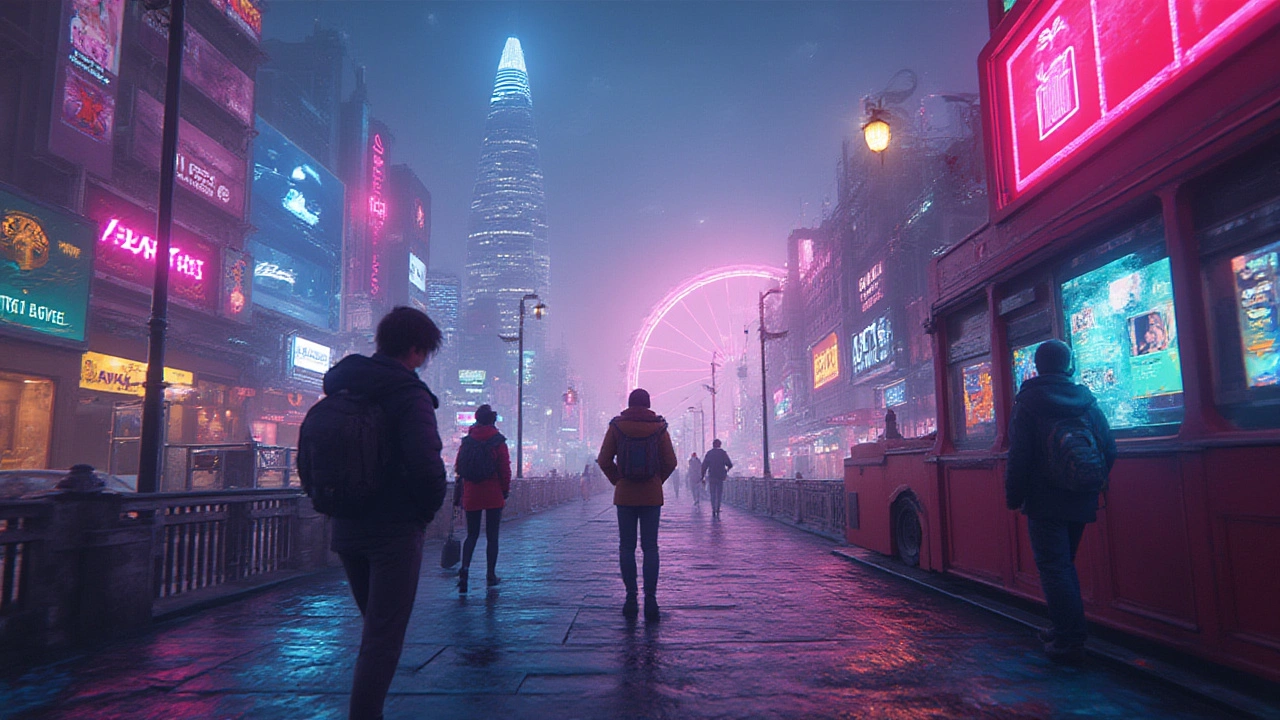Ever noticed a billboard for your favorite snack inside a racing game, or stopped to watch an ad for a new smartphone while waiting for your next match to load? You’re not alone. In-game advertising has snuck its way into our daily gaming sessions, but far from being annoying pop-ups, these ads are changing the rules of digital marketing. The gaming world isn’t just for fun—it’s now a lively marketplace, where brands and players meet in a space more dynamic than any social feed or streaming service. It’s big business. Back in 2024, in-game advertising brought in over $9 billion worldwide, according to Statista. And it’s only getting bigger as the industry draws more eyeballs than movie theaters and TV combined. So, what’s behind the buzz? Do these digital billboards really work, or are they just a clever background? Let’s break down what makes in-game ads unique and how everyone—developers, brands, and yes, even us players—stand to win from this new age of advertising.
Why In-Game Advertising Works So Well
It’s not like ads in games are brand new. Back in the early 2000s, PC racing sims placed real car brands and logos trackside. But the difference now is how seamless and smart these ads are. Developers design games to blend ads so they feel natural. See that soda logo on a basketball court in NBA 2K25? That’s not breaking immersion; it looks like what you’d see on TV during a real NBA game. This realism is a massive win for advertisers, especially now that games are the favorite pastime for people aged 16 to 34. In 2025, we’re looking at roughly 3.4 billion gamers worldwide. That’s almost half the planet. If you’re a marketer, you can’t ignore those numbers.
But it’s not just about numbers. Research from the Interactive Advertising Bureau (IAB) in 2024 showed that 77% of gamers recall at least one brand they saw in a recent game session—way higher than typical banner ads on websites. Games are engaging, and when players see an ad there, it sometimes even adds a touch of authenticity. Think about a soccer game with real brands on the digital billboards, or collectible items in a shooter based on real-life products. Ads in these environments get accepted because they mirror what people expect from reality.
Another key factor: targeting. With loads of data from online play, advertisers can make sure a 24-year-old racing fan in Brazil sees car ads relevant to their region, while a 40-year-old in Germany might notice something else entirely. This super-targeted approach beats traditional TV ads, where everyone sees the same commercial. In-game ads can zero in on interests and habits, making campaigns much more effective. On top of that, brands can measure just how long players looked at the in-game billboard, what actions they took, or even whether they clicked through for more info, depending on the game. The ability to get real, hard data from every impression—that’s a dream for art-and-science marketers.
Finally, there’s the brand boost from being seen as innovative. Companies that jump into gaming show they're in touch with pop culture. Remember the 2023 partnership between Fortnite and Nike? Players could dress avatars in limited edition Nike gear. That campaign sold out the real-life sneakers too, because it made both the brand and the game feel cooler. For brands targeting Gen Z or millennial customers, in-game advertising isn’t a bonus—it’s a necessity.
Different Types of In-Game Advertising
If you think in-game ads are just digital billboards beside virtual highways, think bigger. The formats are getting more creative every year, adapting with the technology and the changing ways we play.
- Static In-Game Ads: Think permanent billboards, posters, or branded scenery built into the game’s environment. These stay the same no matter who’s playing or when. You’ll see these in older sports or racing games, where the advertising assets are “baked” in during development. While less dynamic, they still add realism and can help brands stay top of mind for players revisiting old favorites.
- Dynamic In-Game Ads: With most games now online, advertisers can swap or update ads on the fly. For example, the banners in a FIFA match might change each week to match real-world campaigns. These use tech similar to programmatic banners on websites but match seamlessly with the 3D world. Dynamic ads make it possible to target specific regions or user segments with different creative, and they offer up-to-the-minute reporting back to advertisers.
- Native and Brand Integration: This is where things get interesting. Rather than obvious, obtrusive logos, brands become a natural part of the gameplay. Maybe you pick up a can of Diet Coke to boost health in an open-world RPG, or you’re invited to attend a virtual concert sponsored by a music streaming app in a life simulation game. This immersive type of ad doesn’t feel like an interruption—it deepens the experience or adds something valuable to the player. Animal Crossing's virtual fashion launches or Roblox’s in-game concerts are prime examples. In some cases, real companies pay millions just for limited exposure inside popular games.
- Rewarded Ads: Free-to-play mobile games often give players extra lives, new skins, or bonus items if they watch a short commercial. According to App Annie, nearly 70% of mobile gamers say they’d rather watch a quick video ad than pay real money for content. Developers love this, as it keeps people engaged and gives brands guaranteed eyeballs.
- Advergames: Here, the whole game is basically a playable commercial. These aren’t as common among big-name titles, but fast-food chains, movies, or appliance brands occasionally release simple HTML5 browser games, hoping to go viral while pitching their latest products.
One thing ties all these methods together: they put user experience first. If a brand tries to force its way into a game with pop-ups or spammy videos, gamers get annoyed and bail out. Savvy brands work directly with studios to fit naturally into existing play, making the promo part of the fun—not a mood killer. That’s why more studios now have dedicated teams balancing the right mix of advertising, gameplay, and audience expectations.

Benefits for Brands, Developers, and Players
Let’s break down what everyone gets out of this new marketing playground. For brands, it’s about exposure and engagement. In-game advertising reaches more people, for longer periods, in more personal settings than almost any other channel. Ads in games aren’t just seen—they’re experienced. When you’re driving a virtual Formula One car branded with a real tire company’s logo, your brain connects with that image, often subconsciously. A 2025 survey by the Entertainment Software Association found gamers remember in-game brands twice as long as commercials seen on traditional TV.
Brands can also run creative campaigns impossible outside gaming. Car companies have unveiled virtual models you can drive before they arrive at dealerships. Movie studios have dropped exclusive in-game sneak peeks. Want to tease a mystery or alternate ending for a streaming show? Release clues as Easter eggs hidden in a puzzle game. It’s experimental, interactive, and much more memorable than scrolling past an ad on social media.
Game studios and indie developers get a ton out of this too. In-game advertising provides an extra revenue stream—massively important as the costs of making blockbuster games skyrocket. According to NewZoo, it costs over $200 million to produce a top-tier title these days. For smaller studios, integrating ads in clever ways means they can offer great games for free or low cost, without relying only on in-app purchases or subscriptions. It’s a win-win: advertisers get a captive audience, developers get paid, and players keep their wallets closed.
And yes, players themselves benefit more than it might seem. When in-game ads are well-placed and relevant, they can actually improve realism and immersion. Imagine playing a realistic racer that uses fictional brands for cars and tires—it never quite feels right. But bring in the real-world companies, and suddenly you’re part of a living, breathing landscape. Rewarded ads offer a way for players to level up or get new stuff without shelling out real money. Many studies prove players prefer this to shelling out for microtransactions. Plus, the surge in creative branded events—think Fortnite's virtual Travis Scott concert, which pulled in 12 million live viewers—turns games into social hotspots. People show up for the brand’s event, stick around for the community, and leave with a good vibe instead of ad fatigue.
The critical thing to get right is balance. Too many ads, or ones shoved in your face, break immersion and just annoy. But get the mix right, and everyone walks away happy—brands get attention, studios get paid, and players get more ways to play without draining bank accounts. Recent experiments by mobile hit Subway Surfers (the most downloaded game in history) let users choose when to see ads, boosting both engagement and user satisfaction—a clever move that other developers quickly noticed. The future seems clear: personalized, creative, and respectful ads will keep working because they fit into how players want to experience virtual worlds.
Tips for Making the Most of In-Game Advertising
If you’re on the brand side, thinking of jumping into the gaming universe, there are a few tips and hard-won lessons. First, research the audience. Different games attract different types of people, and pushing a luxury car ad in a fantasy RPG just doesn’t fit. Use analytics: games collect tons of data that can tell you about user age, location, preferences, and spending habits. Partner with developers who know their audience and can help tailor campaigns. Remember, the best in-game ads almost vanish—they blend so well, users don’t consciously notice them, but later recall the brand.
Timeliness matters. Sync campaigns with real-world events. When there’s a big sporting event, or a cultural moment going viral, update your in-game creative to match. Dynamic advertising makes this possible and keeps your message relevant. And don’t forget about the creative itself. Players are sharp; if an ad feels wrong for the game, they don’t just ignore it—they actively complain on forums and social media. Work with developers and even tap player communities for feedback on what feels authentic. Remember Nike’s Fortnite campaign? It worked because it felt like something real players would actually want to see and wear.
If you’re a developer, don’t leave ad integration until the last minute. Build advertising into the game from the planning stage. Involve marketing and user experience teams together, so brand placements and ad experiences don’t stick out like a sore thumb. The best integrations are subtle and thoughtful—ads built into mission briefings, cityscapes, or player rewards are more successful and less intrusive than forced pop-ups.
For smaller studios worried about player backlash, transparency is vital. Let users know how ads keep the game free or help you keep working on new content. Give players control when you can: offering an option to skip or opt in for extra rewards can boost both satisfaction and ad performance.
Gamer? Keep an eye out. Sometimes, in-game ads offer real-life discounts, exclusive game items, or even contest entries. During the 2024 NBA 2K season, players who interacted with certain in-game ads unlocked special codes for discounts on team merchandise. More games are tying real-world perks to in-game actions—a smart way for brands to build loyalty and tap into the fun side of marketing.
Bottom line: in-game advertising isn’t about shoving products in your face. When done right, it’s about adding depth, realism, and even new experiences in the virtual worlds we love. Brands, developers, and gamers all stand to get something valuable out of this interplay. As the industry gets even bigger, expect to see even wilder, smarter, and more fun ways that games and brands come together—proving once again that the gaming universe is never just about play.





